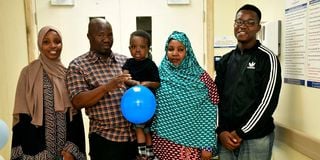Kenyan doctors conduct first aplastic anaemia transplant

Mr Kase Bonaya (second left) holding his three-year-old son Mahadal Kase in celebration after his son's discharge from Nairobi West Hospital on June 13, 2023, after undergoing the first ever Asplastic Anemia Transplant at the hospital.
A team of Kenyan doctors has delivered what is believed to be the region’s first-ever successful aplastic anaemia transplant on a three-year-old child.
Aplastic anaemia is a form of bone marrow failure.
Marrow, the soft, fatty tissue inside bones, is the place where new blood cells are formed.
“God is great, I have not seen my wife and son for the past seven weeks. These doctors have done the impossible,” Mr Kase Bonaya, a police officer based in Nairobi, told the Saturday Nation in reference to the operation on his son, Mahadal Bonaya, as tears well in his eyes.
“It all started in January this year when my son started losing appetite. He grew darker and then blood started oozing from his gums, at first whenever he would brush his teeth, and then it became regular,” Ms Michi Bonaya, Mahadal’s mother, opens up.
The mother of three remembers the night she almost lost her son.
“My son fell so ill at night. Watching him helpless and writhing in pain had me so afraid. I immediately rushed him to the hospital within the Administration Police camp in Utawala.
“The doctor there took one look at him and immediately phoned his fellow doctors, then asked that I rush him to the Nairobi West Hospital.”
No data
In an interview with the Saturday Nation, the team lead, Dr Rohini Radia, a United Kingdom-trained Kenyan consultant who specialises in internal medicine with a focus on haematology, who has been treating the boy, explained that aplastic anaemia is very rare, which is why there is no data even at the Ministry of Health on the condition.
“Acquired aplastic anaemia (AA) is a rare disease, with an estimated frequency — in Europe and in North America — of about two cases per million population per year. There are reports of AA from North Africa (two), West Africa (three), East Africa (four) and Southern Africa (five), but no data on the frequency of this condition,” the American Journal of Hematology notes, adding that only one Tanzanian has undergone a transplant – abroad.
In a peer-reviewed study done by Professor Jessie Githanga focusing on 90 children aged six months to 18 years battling bone marrow failures at Kenyatta National Hospital, the main findings were neoplastic disorders (52.4 per cent) followed by reactive marrow (28 per cent) and nutritional anaemia (8.6 per cent).
“The main bone marrow pathology found was neoplastic disorder while the commonest clinical presentations observed were pallor (51.2 per cent), fever (32.5 per cent), fatigue (27.5 per cent) and bleeding manifestations (20 per cent),” the associate professor in the department of human pathology, University of Nairobi, explained.
“This is excellent news; I am very happy about this historic achievement because this transplant is the most definitive way to cure aplastic anaemia,” Prof Githanga told the Saturday Nation in reference to the work done by Dr Rohini and his team.
Dr Rohini further explained that with this condition, the bone marrow does not produce new cells, leaving the body susceptible to bleeding and infection.
Although scientists still cannot identify the exact cause of aplastic anaemia, factors that increase one’s risk of contracting it include autoimmune disorders such as eosinophilic fasciitis or lupus, drugs and chemical exposures and infections such as HIV or epilepsy.
Others include medical procedures such as radiation therapy or chemotherapy, paroxysmal nocturnal hemoglobinuria — an acquired disorder where red blood cells break down too quickly — a family history of bone marrow failure syndrome and pregnancy.
Attacks own tissues
In most cases, she notes, severe aplastic anaemia occurs when the body’s immune system attacks its own tissues and organs and though it is not a cancer, its treatment can be similar to those of leukaemias and lymphomas.
“Today is a historic moment because there is a huge need for patients who need bone marrow transplants for haematological disorders in this country. We had a young man who’s three years old admitted to the facility on March 7 this year with very low blood cells,” Dr Rohini told the Saturday Nation.
“For low blood cells, we look at haemoglobin. White cells, which help you fight infections, were low and the platelets, which help the blood to clot when you cut yourself, were also low.
When all cells are low you have to look into the bone marrow, which is the factory where the cells are made, to determine the diagnosis and the cost.”
Lancet Pathologists Kenya agrees with Dr Rohini. “The most common cause of aplastic anaemia is a case of your immune system attacking the stem cells in your bone marrow. Other factors that can injure bone marrow and affect blood cell production include radiation and chemotherapy treatments.
While these cancer-fighting therapies kill cancer cells, they can also damage healthy cells, including stem cells in the bone marrow. Aplastic anaemia can be a temporary side effect of these treatments,” they explained, adding that treatment for aplastic anaemia might include medications, blood transfusions or a stem cell transplant, also known as a bone marrow transplant.”
“Aplastic anaemia can be short-lived chronic. It can be severe and even fatal.
There's no prevention for most cases of the condition.”
Two tests
The pathologists add that two tests can help diagnose aplastic anaemia.
“One is a blood test. Normally, red blood cell, white blood cell and platelet levels stay within certain ranges. In aplastic anaemia, all three blood cell levels are low.
“The second is bone marrow biopsy. A doctor uses a needle to remove a small sample of bone marrow from a large bone in your body, such as your hipbone. The sample is examined under a microscope to rule out other blood-related diseases.”
Dr Rohini is kind enough to detail to the Saturday Nation how she and the team treated Mahadal for more than seven weeks in a procedure that would change his life forever.
“The three-year-old boy first underwent investigation as well as supportive care through blood and platelet transfusions. He needed antibiotics because of infections due to low white cell count and upon doing bone marrow tests, we found him to have aplastic anaemia, which is rare worldwide but is considered benign,” Dr Rohini said.
“The body needs its own system to help fight infections.”
The TNWH team consulted widely and, according to Dr Rohini, they had to design a perfect treatment with what they had.
Dr Rohini explains that for this to work, Mahadal’s non-functioning bone marrow had to be destroyed with drugs and/or radiation, then replaced with donor bone marrow from a compatible donor, usually a sibling or any other family member.
She discloses that bone marrow transplants from unrelated donors or donors that do not match a patient’s bone marrow characteristics are usually saved for severe aplastic anaemia or very severe aplastic anaemia patients who have not responded to drug therapy first.
“My name is Halima Kase. I am 20 years old and a student at New Coast Medical Training College pursuing orthopaedic and trauma medicine, I am Mahadal’s donor,” the patient’s sister introduces herself.
“I was so elated when my bone marrow matched with his. This was in May this year and so I came for stem cell harvesting last month.
It was not an easy experience at first but the doctors and nurses made it very comfortable and much easier. I am so happy that today I get to finally go home with my brother after three months,” she told the Saturday Nation in an interview.
Johns Hopkins Medicine observes that when successful, a bone marrow transplant is often a cure for aplastic anaemia, with few cases of relapse. “However, it is a very intensive therapy, and serious immune complications and infections are not unusual. Other non-life-threatening effects of bone marrow transplantation include sterility and temporary hair loss,” the experts say, adding that patients under age 40 are the best candidates.
“I am very grateful to the government because I haven’t spent a single cent on my son’s treatment and would have sold everything I own were it not for the National Police Service insurance, cover which catered for everything.
“Seeing my son laugh, run around the hospital premises and play means the world to me,” Mahadal’s father told the Saturday Nation.





